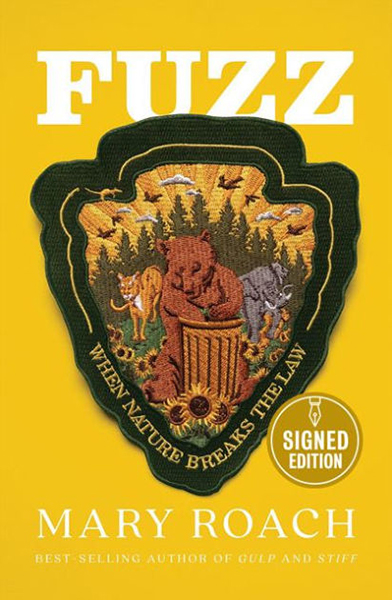calsfoundation@cals.org
6BBF Author Profile: Mary Roach
 Mary Roach has an easy, light humor about her, so it’s no surprise that she would take complex scientific topics and naturally inject humor into them. Roach began her career in magazine writing and claims she had “no real sellable talents,” though that is clearly not the case. She says that her career was shaped by the relationships she made with a few key editors, such as an editor from Discover who approached her about writing for the magazine. She found the stories fun to write and incredibly interesting, so she became a science writer, even though ending up there wasn’t a conscious decision at the time. And there, it turns out, is a great place to be.
Mary Roach has an easy, light humor about her, so it’s no surprise that she would take complex scientific topics and naturally inject humor into them. Roach began her career in magazine writing and claims she had “no real sellable talents,” though that is clearly not the case. She says that her career was shaped by the relationships she made with a few key editors, such as an editor from Discover who approached her about writing for the magazine. She found the stories fun to write and incredibly interesting, so she became a science writer, even though ending up there wasn’t a conscious decision at the time. And there, it turns out, is a great place to be. 
Her previous five books range in topic from human cadavers to sexual psychology, and, in her latest, she explores our weird world in which animals and humans must coexist. As informative as it is funny, Fuzz breaks down animal attack forensic investigations and pokes fun at a jaywalking moose. In advance of Roach’s upcoming session for the Six Bridges Book Festival, CALS was able to briefly talk with the author about the process of researching and writing Fuzz.
CALS: For someone who isn’t familiar with your writing, describe what they can expect from your books.
Roach: They can expect to be surprised and amused, hopefully. When people hear the topics of my books, they think they sound heavy. With non-fiction, some people expect a slog, but they are fun and goofy—I put a premium on fun.
CALS: What inspires you? How did you pick your latest topic?
Roach: Anytime I stumble onto some pocket of science I’ve never heard of, I get interested. Like, the science of human-wildlife conflict. It’s a legitimate branch of science that I had no idea existed. For instance, military research (for Grunt) into how to keep combatants safe, just the military science of keeping people alive, is counterintuitive and has fallen through the cracks.
CALS: What was the process behind writing your latest book, and how was it different from your previous five?
Roach: It’s a similar basic process: I start with the lay of the land and scout locations, what would make the most interesting narrative for a chapter. I don’t want a chapter where I’m just sitting and talking; I want to be there where the action is happening. It’s a huge topic—there are thousands of species and hundreds of topics of human-wildlife conflict—but I needed to find a place where I wasn’t a pain to tag along. Then I’m adding peripheral interviews, since I’m writing chapters at the same time I’m working on other chapters. For most of the process I’m doing both, then toward the end, I’m doing heavier writing.
CALS: This book involved a lot of travel. Where did it take you?
Roach: I was in New Zealand, Vatican City, and the U.S., mostly (in the U.S.: Colorado, California, Nevada). Then there are some historical chapters; I obviously didn’t time travel for those. I was out at the national wildlife research center also.
CALS: What was your favorite?
Roach: I think the trip to Vatican City, partly because you don’t expect that. And I’d never been to the Vatican. The research was fun and a little quirky. I enjoyed my time in New Zealand; the South Island is incredibly beautiful.
CALS: Is there a story that got cut from this book that you wish hadn’t?
Roach: For this book, initially I was going to cram together “animal crimes” but also the other way around, when it’s poachers and materials from these animals; there is this one story that was fascinating, the case of the missing walrus heads in Alaska, and another with counterfeit tiger penises, and I was sad to not include those, but it was thematically messy to include them. I dropped them. I even went up to Oregon and invested some time into it but at the end, you have to let it go.
CALS: According to your second chapter in Fuzz, you joke that bears prefer Häagen-Dazs. What’s your favorite ice cream?
Roach: My favorite kind of ice cream has these big chunks of chocolate fudge brownies; I think it’s Ben and Jerry’s—not the fudge, but the fudge brownies. I also like some of the Talenti flavors, but it’s maybe a little sweet.
CALS: What can someone expect from your Six Bridges session?
Roach: I’m going to be accompanied by Charles Kokes, the chief medical examiner for the State of Arkansas. In my first chapter, I talk about how I went to this five-day training on animal attacks—in this, we talked about the nitty gritty of the forensics of what species of animals killed the victim, so I think it will be a fair amount about that. I think it’s fun when the interviewer is from a different background. I think we will have some fun.
Follow Roach on Twitter, and mark your calendar for her virtual session on Thursday, October 21, at 8 p.m. And, if you’re curious about those walrus heads, you can read the story here.
Recent Comments